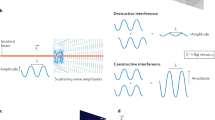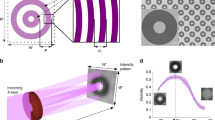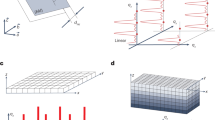Abstract
Improved synchrotron sources provide new opportunities for the studying the structure and kinetics of biological materials using non-crystalline diffraction and small angle scattering.
This is a preview of subscription content, access via your institution
Access options
Subscribe to this journal
Receive 12 print issues and online access
$189.00 per year
only $15.75 per issue
Buy this article
- Purchase on Springer Link
- Instant access to full article PDF
Prices may be subject to local taxes which are calculated during checkout

Similar content being viewed by others
References
Huxley H.E. The working stroke of myosin– crossbridges. Biophys., J. 68, 57–58 (1995).
Wakabayashi, K., Sugimoto, Y., Tanaka, H., Ueno Y., Takezawa, Y. & Amemiya, Y. X-ray diffraction evidence for the extensibility of actin and myosin filaments during contraction. Biophys. J. 67, 2422– 2435 (1994).
Huxley, H.E., Stewart, A. Sosa H., & Irving, T.C. X-ray diffraction measurements of the extensibility of the actin and myosin filaments in muscle. Biophys. J., 67, 2411– 2421 (1994).
Irving, M., Lombardi, V., Piazzesi, G. & Ferenczi, M.A. Myosin head movements are synchronous with the elementary force-generating process in muscle. Nature 357, 156– 158 (1992).
Lorenz, M., Poole, KJV, Popp, D., Rosenbaum, G. & Holmes, K.C. An atomic model of the unregulated thin filament obtained by X-ray fiber diffraction of oriented actin-tropomyosin gels. J. Mol. Biol 246, 108–119 (1995).
Rawe, I.M., Leonard, D.W., Meek, K.M. & Zabel, R.W. X-ray diffraction and transmission electron microscopy of Morquio syndrome type A cornea: A structural analysis. Cornea 16, 369–376 (1997).
James, V.J., Yue, D.K. & McLennon, S.V. Changes in molecular structure of hair in insulin-dependent diabetes. BBRC 233:76–80 (1997).
Misof, K., Rapp, G. & Fratzl, P. A new molecular model for collagen elasticity based on synchrotron X-ray scattering evidence. Biophys. J. 72, 1376–1381 (1997).
Laggner, P. & Kreichbaum, M. Phospholipid phase transitions: kinetics and structural mechanisms. Chem. Phys. Lipids 57, 121–145 (1991).
Cheng, A., Hummel, B., Mencke, A. & Caffrey, M. Kinetics and mechanism of the barotropic lameller gel/lameller liquid crystal phase transition in fully hydrated dihexadecylphosphatidylethanolamine: a time resolved X-ray diffraction study using pressure jump. Biophys J. 67, 293–303 (1994).
Koch, M.H. et al. Time-resolved X-ray diffraction study of structural changes associated with the photocycle of bacteriorhodopsin. EMBO J. 10, 521–526 (1997).
Trewhella, J. Insights into biomolecular function from small-angle scattering. Curr. Opin. Struct. Biol. 7, 702–708 (1997).
Meyer, D.F. et al. Time-course studies by synchrotron X-ray solution scattering of the structure of human low-density lipoprotein during Cu(2+)-induced oxidation in relation to changes in lipid composition. Biochem J. 319, 217–27 (1996).
Arai M. et al. Kinetic refolding of beta-lactoglobulin. Studies by synchrotron X-ray scattering, and circular dichroism, absorption and fluorescence spectroscopy. J Mol. Biol. 275:149– 62 (1998).
Irving, T.C. & Huxley H.E. In Muscle diffraction at the Cornell high energy synchrotron source: synchrotron radiation and the biosciences (eds Chance, B. et al.) 519–529 (Oxford University Press, Oxford; 1994).
Tsuruta, H. et al. A wide bandpass monochromator for synchrotron radiation with small-angle and fiber diffraction applications. J. Appl. Crystallogr. in the press (1998).
Author information
Authors and Affiliations
Rights and permissions
About this article
Cite this article
Irving, T. Bright prospects for biological non-crystalline diffraction. Nat Struct Mol Biol 5 (Suppl 8), 648–650 (1998). https://doi.org/10.1038/1340
Issue Date:
DOI: https://doi.org/10.1038/1340



